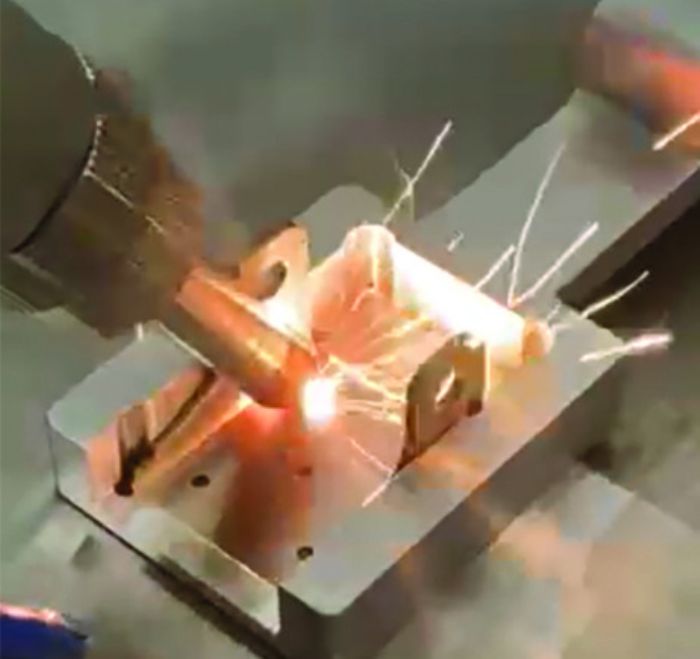Dedicated Robotic Process vs. Cobot-Led Laser Welding
 A proper discussion of cobot laser welding would be incomplete without a comparison to purpose-built robotic laser welding. Purpose-built systems, according to Cobot Systems officials, are best suited for applications with simple component geometry, and requiring repetitive welding tasks and extreme welding precision. Cobot laser welding finds a sweet spot with complex component geometries requiring multi-step welding processes and processes that require frequent reprogramming. Given the above, “purpose-built setups prove better for medium to high part volumes while cobot setups function better in high-mix, low-volume environments,” says Knopp.
A proper discussion of cobot laser welding would be incomplete without a comparison to purpose-built robotic laser welding. Purpose-built systems, according to Cobot Systems officials, are best suited for applications with simple component geometry, and requiring repetitive welding tasks and extreme welding precision. Cobot laser welding finds a sweet spot with complex component geometries requiring multi-step welding processes and processes that require frequent reprogramming. Given the above, “purpose-built setups prove better for medium to high part volumes while cobot setups function better in high-mix, low-volume environments,” says Knopp.
The ROI Case
All of these advantages demand close consideration from fabricators tasked with welding parts that mesh with the capabilities of cobot-led laser systems. Knopp’s blog points out some financial facts to keep in mind.
Upfront costs for cobot laser welding include the initial investment in the cobot-welding system as well as necessary accessories. Also keep in mind installation and setup expenses that ensure a correctly configured workspace for cobot integration. And, the need to meet regulatory standards and ensure a safe working environment entails initial safety-equipment and compliance costs.
Operations-wise, expect ongoing energy-consumption and maintenance costs, as well as costs related to consumables such as laser gases, optics and other replacement parts. Factor in, too, training costs to ensure properly prepared employees for cobot-welding-system operation and maintenance.
This general cost overview provides a foundation for determining ROI.
Knopp proposes a simplified hypothetical scenario with an initial investment of $150,000 in a cobot-laser-welding system that also needed accessories. Such a setup, depending on component volumes and system green time, may yield annual savings over traditional welding processes of $50,000 for labor, via faster welding cycles and reduced reliance on manual labor; $20,000 caused by scrap reduction, due to improved weld quality and repeatability; and $10,000 of savings for maintenance, based on easier upkeep of cobot-laser welding setups. This places ROI at about 24 mo., relates Knopp. He explains that the $50,000 in labor savings represents savings across a single 8-hr. shift.
“Many companies,” he says, “work two or three shifts, which would accelerate ROI and reduce the payback period even further.”
While the ROI example above is hypothetical, cobot-led laser welding has proved its worth in the real world, as the experience of Quality Tooling & Repair (QTR) shows. QTR is a Cobot Systems sister company in North Versailles, PA—both were recently acquired by Cutting Edge Machining and Automation.
Prior to employing cobot laser welding, QTR had been manually performing production gas-tungsten-arc welding (GTAW) at the rate of 90 min./component. The firm sought a significant cycle-time reduction. Channeling its machine-tending experience with cobots, QTR married that technology with laser welding to drastically reduce the aforementioned cycle time to 10 min./component. In addition, QTR officials report elimination of other problems such as distortion previously encountered with the GTAW process. And, laser welding eliminated the need to clean parts.
Following this successful trial experience with the cobot, QTR and Cobot Systems worked to standardize the cobot-laser-welding system and offer it to the fabricating community. MF
View Glossary of Metalforming Terms
See also: Cobot Systems
Technologies: Pressroom Automation, Welding and Joining







 In particular, laser welding offers significant advantages in volume production over traditional welding methods, primarily when joining thin materials—carbon and stainless steels as well as aluminum in thicknesses less than 0.25 in. Tightly focused laser beams enable high-quality welds while minimizing heat input, which adds to weld quality while allowing immediate post-weld handling. Low heat input also means minimal part deformity or shrink. And, narrow welds achieve impressive depth and high strength while proving exceptional for joining very small components. Another plus for laser welding: the ability to join a variety of materials, including dissimilar alloys.
In particular, laser welding offers significant advantages in volume production over traditional welding methods, primarily when joining thin materials—carbon and stainless steels as well as aluminum in thicknesses less than 0.25 in. Tightly focused laser beams enable high-quality welds while minimizing heat input, which adds to weld quality while allowing immediate post-weld handling. Low heat input also means minimal part deformity or shrink. And, narrow welds achieve impressive depth and high strength while proving exceptional for joining very small components. Another plus for laser welding: the ability to join a variety of materials, including dissimilar alloys.

